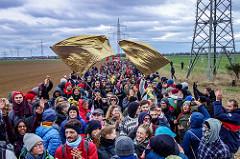
Trainers van Vredesactie reisden de afgelopen jaren regelmatig af naar het Duitse Rijnland. Het doel? Mensen ondersteunen in hun massale acties van burgerlijke ongehoorzaamheid. De acties zijn gericht tegen de bruinkool-ontginning door RWE. Deze bruinkool wordt als fossiele brandstof gebruikt voor de energie-industrie. Dit keer klokte het deelnemersaantal af op 6500 personen. Samen met het Duitse trainersnetwerk Skills for Action trainden we de dag voor de massale blokkade zo'n 1000 actievoerders om tijdens de actie krachtiger in hun schoenen te staan. Inspirerend, blij dat we daar deel van zijn! Volgend artikel (in het Engels) van War'Resisters International geeft een boeiende blik achter de schermen, over de strategische keuzes, het actiemodel en het succes van Ende Gelände: tot hier en niet verder!
(Bron: https://www.nonviolence.wri-irg.org)
How to shut down a coal mine: how Ende Gelände organise mass actions
For several years, Ende Gelände have been organising mass civil disobedience actions against lignite coal mining in Germany, with thousands of participants taking action each year. We interviewed two women active in Ende Gelände, to find out how they have managed to build and sustain such actions.
Ende Gelände is a “broad alliance of people from the anti-nuclear and anti-coal movements, the Rhineland and Lausitz climate camps and the Hambacher Forest anti-coal campaign” - how was the alliance formed, how does it organise itself, and what are its goals? How many people are directly involved in the day-to-day work of the network?
The alliance was formed late in 2014 at an international action conference in Germany, when discussions of what to do about the climate summit in Paris in 2015 started. One part of the group decided to work on the Paris climate summit, another part of the group that later became Ende Gelände decided to organise a mass action in one of the coal mining areas in Germany. The idea was based also on the experience of the Block G8 action (2007) in Heiligendamm in Germany, where mass blockades of the G8 summit had been quite successful. The time seemed ripe for a mass blockade and at the same time from focusing our attention away from the climate summits, and to a more local, yet radical event. Differently from the summits that the anti-globalisation movements had been protesting against (e.g. WTO summits), the climate summits were less suitable as symbolic targets, since their function is more ambiguous: while it had a become clear over the years that not much real progress on combating climate change was to be expected from the international climate change negotiations, many of us are not opposed to international climate change agreements as such. We decided that we needed to start the coal phase out from below, by blocking the lignite mines with our own bodies.
Ende Gelände defines itself as an alliance whose focus is on civil disobedience actions against lignite goal mining. Our goals are to fight for global climate justice by stopping climate change and the structures supporting it at local levels. We therefore push for an immediate coal phase-out in Germany, which the biggest global producer of lignite coal, the type of coal most harmful in the context of climate change. At the same time, we work in solidarity with climate change activists and movements elsewhere.
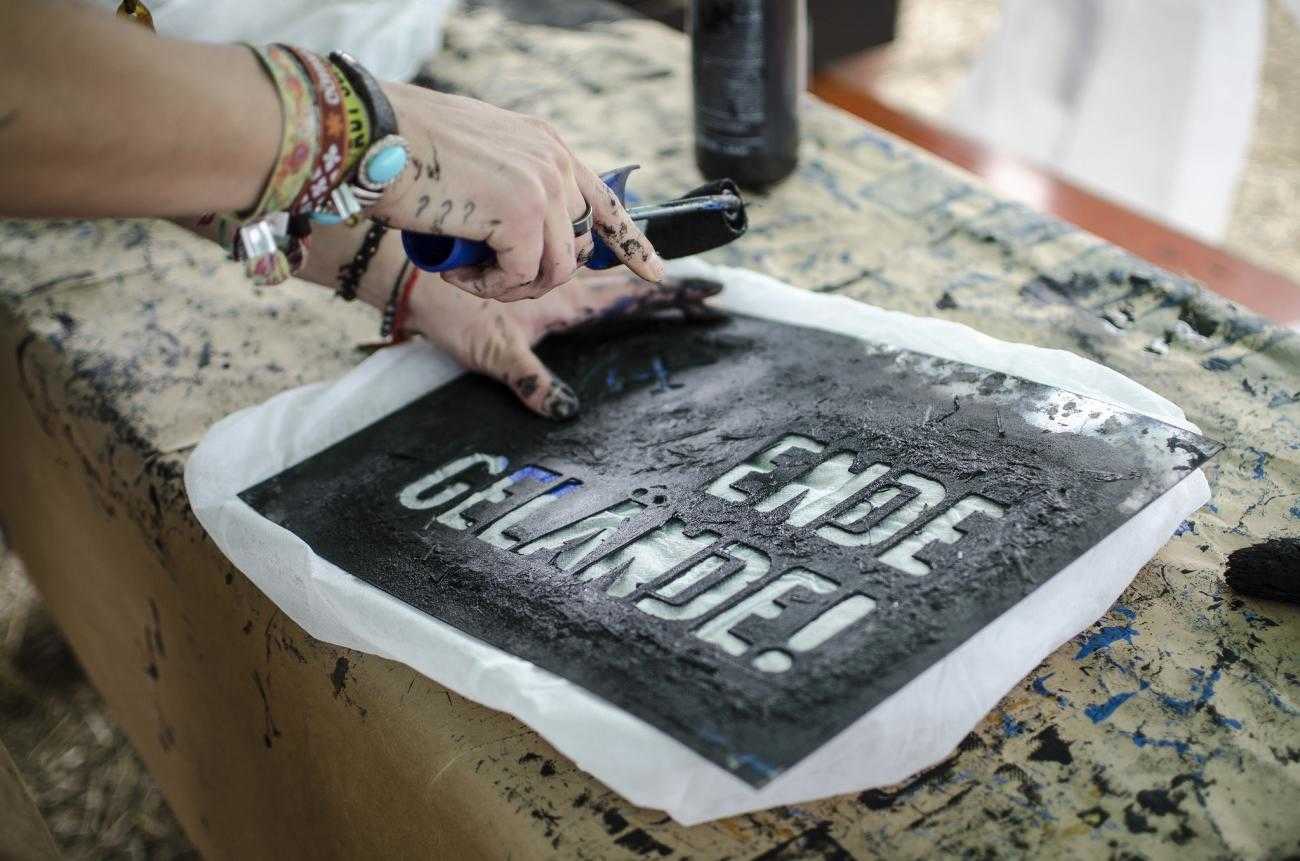
Printing "Ende Gelände" on to clothing for a mass action. Photo: Flickr/Ende Gelände. Licensed under CC2.0
We understand that capitalism is at the root of the climate crisis and we therefore seek to change the public debate around a coal phase-out. The idea of “green growth” is quite strong in Germany, and we as Ende Gelände try to create a counter-narrative to this: We need to overcome capitalist structures and organise our society in a more equitable way, and this will also stop the destruction of our planet. We want to show that ecological issues have a strong social dimension, and solutions to environmental problems need to address questions of justice and power relations. We are trying to radicalise the social conflict over coal and a coal phase-out and try to build bridges between different political actors in Germany (NGOs, local initiatives etc.); we also link our struggle in Germany to struggles for climate justice around the world.
We are organised in working groups (e.g. media mobilisation, action, legal). On the way, we have added some groups that turned out to be useful, e.g. process, camp, logistics. Often, when new topics emerge, we form temporary working groups that work on a specific topic for a set period of time. On current example is the coal commission set up by the German government to discuss the coal phase out in Germany.
Within certain working groups such as our media work group we try to make sure that different political views and actors involved in Ende Gelände are represented. The working groups have a high degree of autonomy and are generally trusted by the broader alliance to organise their work themselves.
The alliance itself meets physically about every six weeks in a different German city. In between meetings we have phone calls every two weeks to which all working groups send delegates, and which can take decisions that cannot wait until the next meeting.
Moreover, we have local groups in many cities that both support the work at the national level and engage in local activities. Their number has increased significantly over time.
Our decision-making is consensus-based.
We have not counted how many people are active in the network at any given time; during our Germany-wide meetings, there are normally 60-100 participants, but not all of us participate in every meeting. Our Germany-wide mailing list has 500 subscribers currently, but not all of these people are active members. It is an important feature of our network that it is very open and actively seeks to integrate new people through a variety of mechanisms.
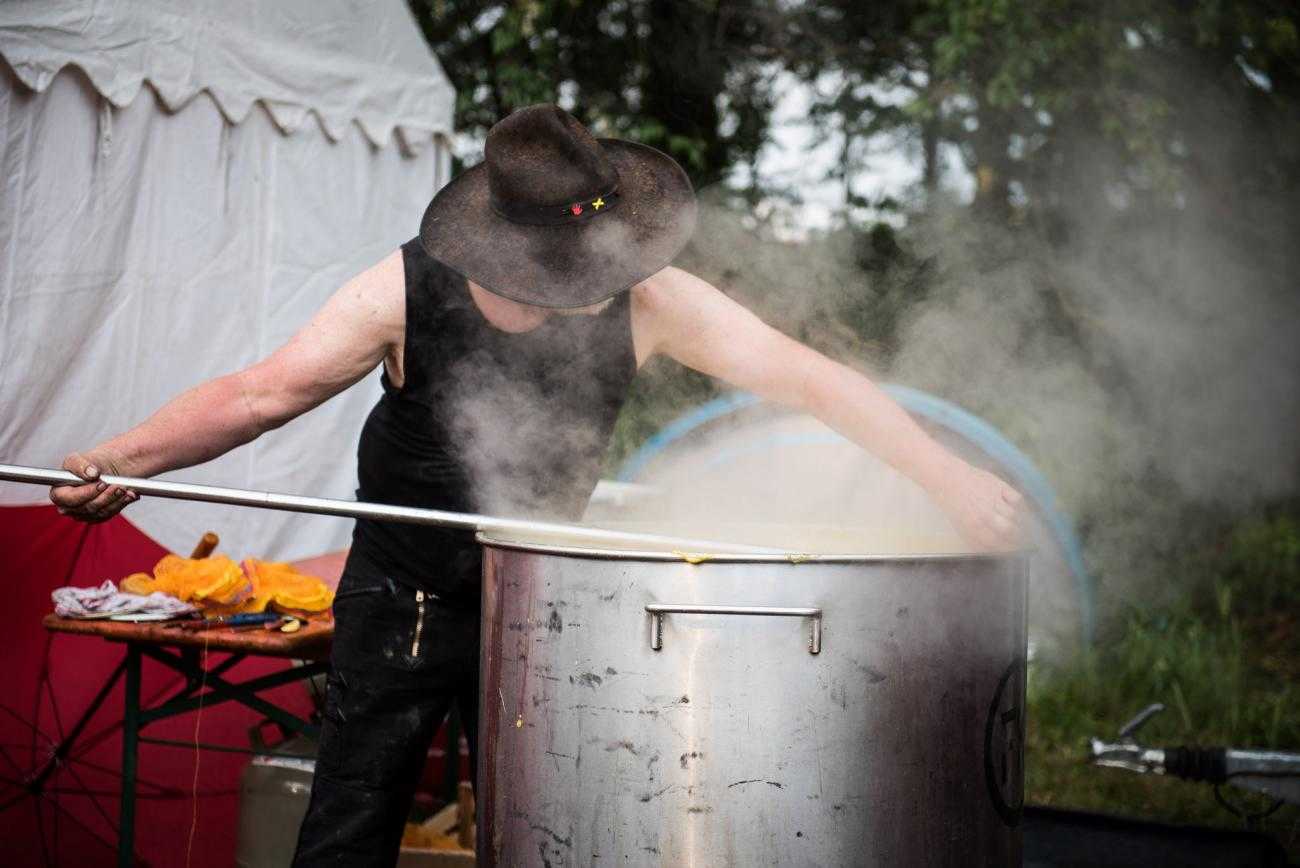
A member of Ende Gelände prepares dinner in one of the action camps. Photo: Flickr/Ende Gelände. Licensed under CC2.0
For several years Ende Gelände has become known for organising mass actions at different open-pit coal mines in Germany, with thousands of people taking part. What is the idea behind holding such mass actions – why did you decide this as the strategy, and what has its impact been?
We think that mass actions are a good way of attracting broad public attention. The actions are organised in a way that allows people, who have never been to a similar action, to participate.
We are taking the fight to places where climate injustice is produced in the literal sense, thus drawing attention to the fact that the relocation of entire villages and communities as well as massive environmental destruction are taking place in Germany, the apparent climate leader of the world. By using our bodies to block the mining and by taking actions that break that law (with all the potential consequences) we point to the urgency of more effective action against climate change and halting lignite coal mining in Germany.
The Ende Gelände actions seem to be a powerful experience for activists, often they see the destruction of coal mining for the first time during an action. The actions entail a very immediate physical experience too: exhaustion, coal dust, heat or mud. And at the same time there are real effects of these actions: a power plant is shut down, a digger stops, work at a mine has to come to a halt etc.
The collective moment of taking part in an action with many others creates a strong sense of belonging, meaning, empowerment and strength as a movement. Also it is safer when many people participate, when the press is present and when repression by courts at a later stage is met by a collective structure (e.g. a legal team).
Ende Gelände has helped to shift the debate on a possible coal phase-out towards a definite “needed and possible soon”. In Germany, a government commission has recently been established to develop a plan for Germany’s coal phase-out. While we are critical of the details of how this commission functions, it shows that the political debate on coal in Germany has shifted and we believe that we have contributed to this.
Additionally we have pushed for the idea that civil disobedience is a necessary and legitimate tool in political struggles. After the G20 summit in Hamburg in 2017, the legitimacy of civil disobedience tended to be questioned in public debates, but Ende Gelände with its strong action consensus is still seen as a positive example for civil disobedience. Outsiders sometimes have referred to Ende Gelände together with protest against the North Dakota access pipeline as “one shining example for civil disobedience”.
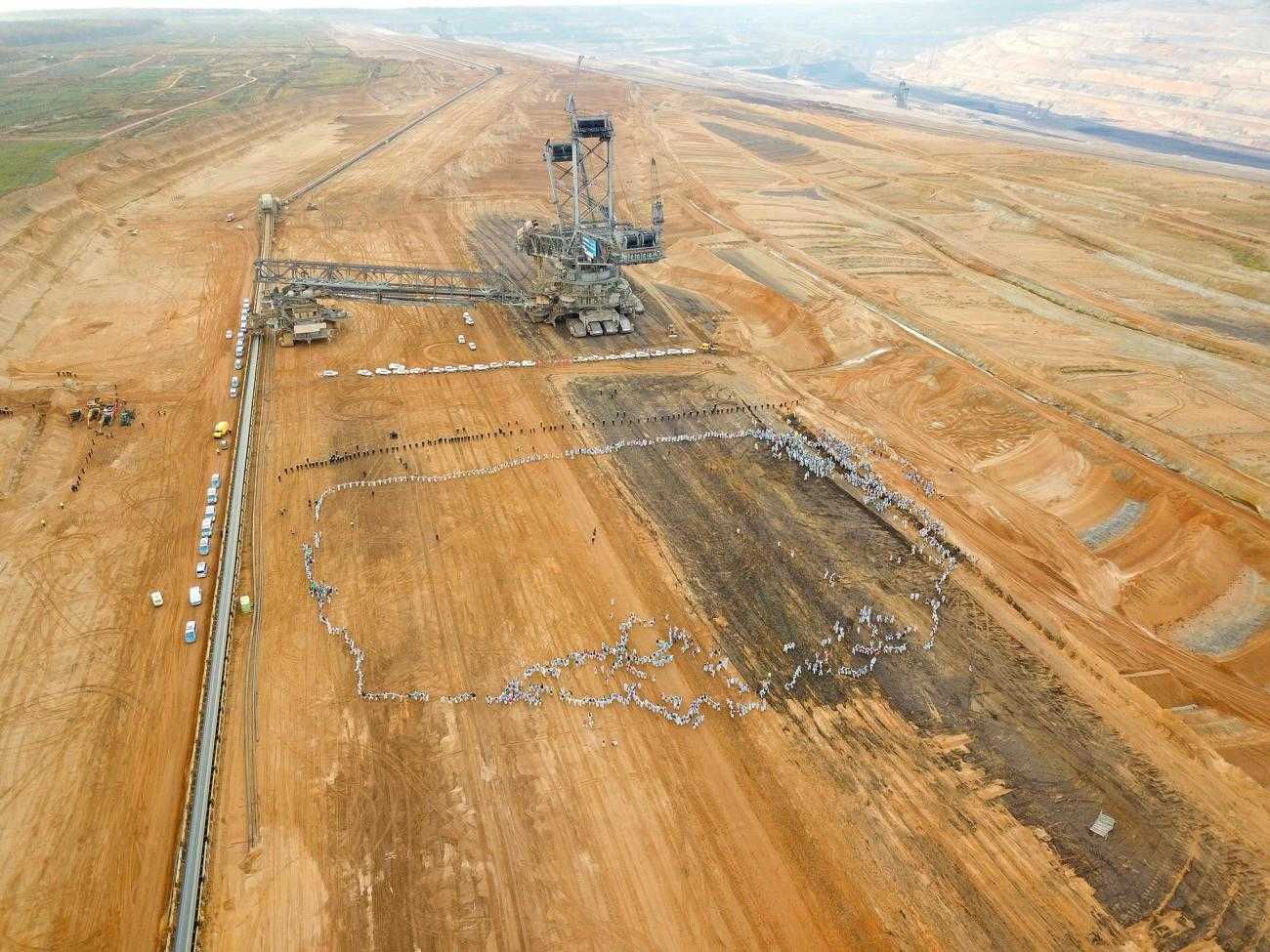
An Ende Gelände action in a coal mine. Photo: Flickr/Ende Gelände. Licensed under CC2.0
It seems each year the action has got bigger, with more and more people getting involved. What do you think led to Ende Gelände being successful in organising such big actions? How have you managed to mobilise thousands of people to take collective action?
Several factors have converged to make this success possible. Yet probably different people in our alliance would have different views on the respective importance of each of these factors, so we cannot rank them by importance:
First, the actions have a very plausible target – it is very clear that lignite coal mining is harmful for the climate and we are going to the exact place where it happens, i.e. a very symbolic place. Moreover, we are successfully exploiting a contradiction in German politics: the German government has ambitious climate goals and Germany has the image of being a frontrunner in climate matters. At the same time, it is the biggest producer of lignite coal in the world. And the production of energy from lignite coal is not necessary to cover Germany’s energy needs…
Second, Ende Gelände is able to build on the work of and form coalitions with others. For a long time, there has been resistance from local communities affected by the mines and we are building on thheir work. Also, NGOs have started to campaign on coal mining. Internationally, in the past decade or so a climate justice movement has emerged in Europe and Ende Gelände is partially building on that network for international mobilisation. And last not least, German used to have a strong anti-nuclear movement (and other movements) on the experience and infrastructure of which Ende Gelände is building. The anti-nuclear movement was likely one of the factors behind Germany’s decision to phase out nuclear energy.
Third, we have been able to offer a convincing narrative for each of our actions. For example, in 2016 we went into a coal mining area in the Eastern part of Germany, where Vattenfall (a company owned by the Swedish state) planned to sell its mining business to a private investor. We asked Vattenfall to close down the mines rather than selling them (which unfortunately they did not, but it was still a plausible story line). In November 2017, we did an action during the time of the climate summit in Germany and right next to the town, Bonn, where the summit took place. We used the proximity of the lignite coal mines and the conference halls to point out how climate-unfriendly Germany’s energy policy actually is. By going into the mines in our white overalls, we were also able to create quite spectacular images – the mines look terrible, the diggers are enormous and then you see all these small people in white overalls blocking them with their bodies… This year, our action will be close to the Hambacher Forst, an ancient forest that is being cut down to extend a lignite call mine, all while there is an official political debate about the coal phase out. People have fought for the “Hambi” as we call the forest for years. The ongoing eviction of people that have lived in the forest for years and the imminent threat to cut down whatever little part remains of the once huge forest have became a Germany-wide political topic before a court issued an order that the cutting down of the of forest had to be stopped, at least temporarily.
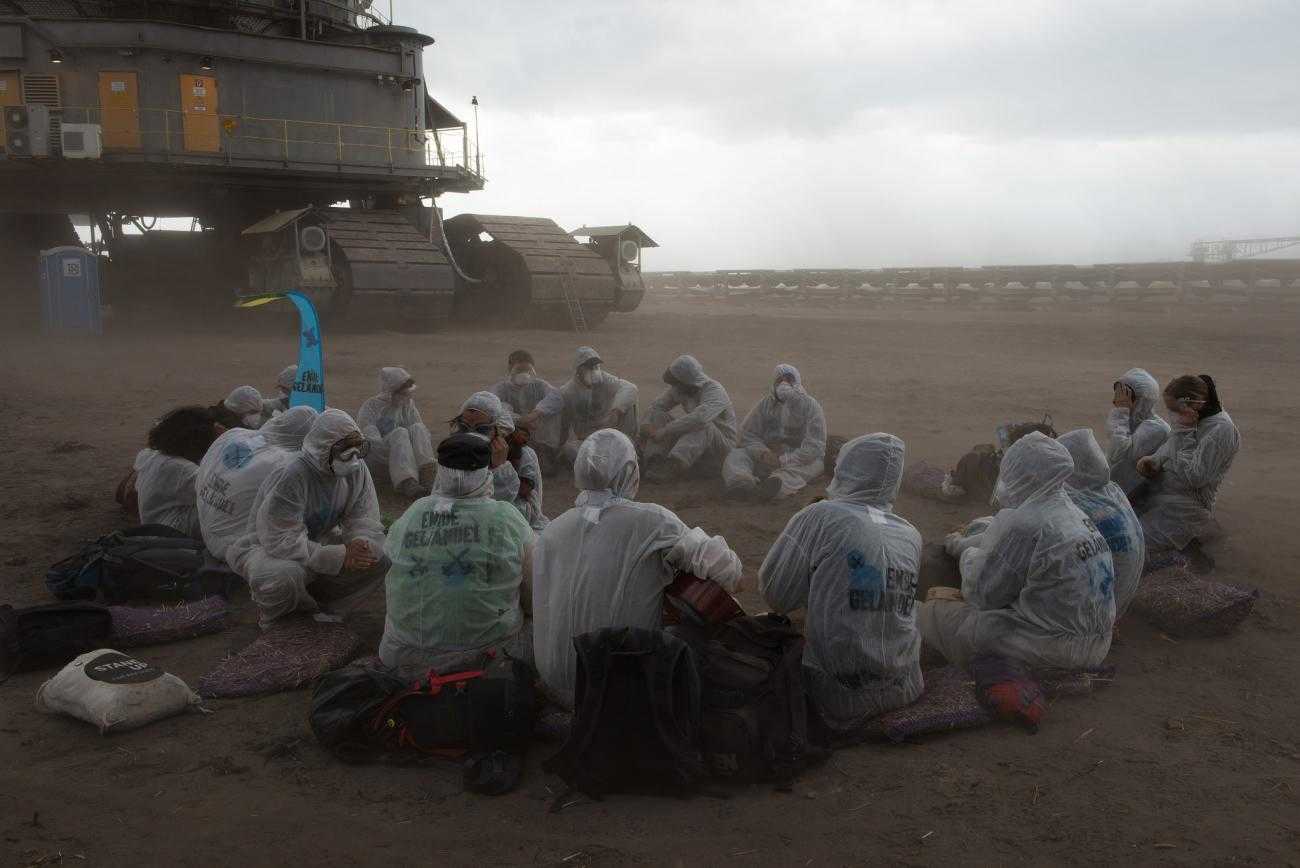
Activists in the coal mine in 2016. Photo: Flickr/Ende Gelände. Licensed under CC2.0
Fourth, the actions are done in a way that different people and groups can support them and participate. Each year, we have what we call an action consensus, i.e. a short description of what we want to and do not want to do in the action. In this action consensus, we make clear that we will engage in civil disobedience, be determined, and break laws (if necessary), but at the same time we also stress that weare peaceful and do not intend to attack anyone. We deliberately do not use the term non-violent. This allows both people who consider themselves non-violent and people with a more militant approach to participate. We have also managed to rally people with different political ideas: In the context of Ende Gelände people who think that we need to overcome capitalism, and stopping climate change is one part of this, meet with those who think that we need to stop climate change, and overcoming capitalism is one part of this.
Moreover, because it is a mass action with a lot of planning before, a lot of guidance for activists, trainings offered before and a supportive background structure, it is also possible for people who have not participated in similar actions before to join us. For many of the people that are in the action, the experience is exhausting and sometimes scary, but also very empowering and meaningful – so some come back.
Fifth, while the action itself can often feel chaotic while it is underway, it is probably still comparatively well organised. We do prepare well and over a period of several months, there is a lot of experience we can draw on, a lot of training, skill-sharing etc. Also, we try to celebrate success and we do not leave people alone when facing legal consequences after the actions.
Sixth, we are very open to new people joining our network and actively encourage people to take on responsibilities, among others by doing a lot of internal skill sharing. We have also over the years created local groups in many cities, which are easily accessible ways for people to get involved. Bringing new people into the network is one way of preventing burn-out among activists and encouraging what we call sustainable activism – a kind of activism, in which people do not drop out after a few years from exhaustion or frustration and can be active in line with the time and energy they have (which may also vary over time). At the same time, being welcoming to new people is a way of making our network grow: if people feel that they are needed, that they can make a difference and can actually do things they may have never done before in their lives, this is very motivating. Ende Gelände is a fantastic learning space (as many other social movements and activist spaces are).
Seventh, we practice consensus-based decision-making. We seek to ensure good facilitation, have an active approach towards dealing with internal power structures, try to express our appreciation of each other’s work, allow ourselves to make mistakes (while trying to learn from them), celebrate our successes, give ourselves time and space for dealing with emotions and regularly embark on a process of collective reflection. Many of us have formed friendships within Ende Gelände.
Eighth, we do not leave people alone when faced with repression. Some of us have faced criminal charges for e.g. trespassing; people know that they will not be left alone in the court room or with paying fines.
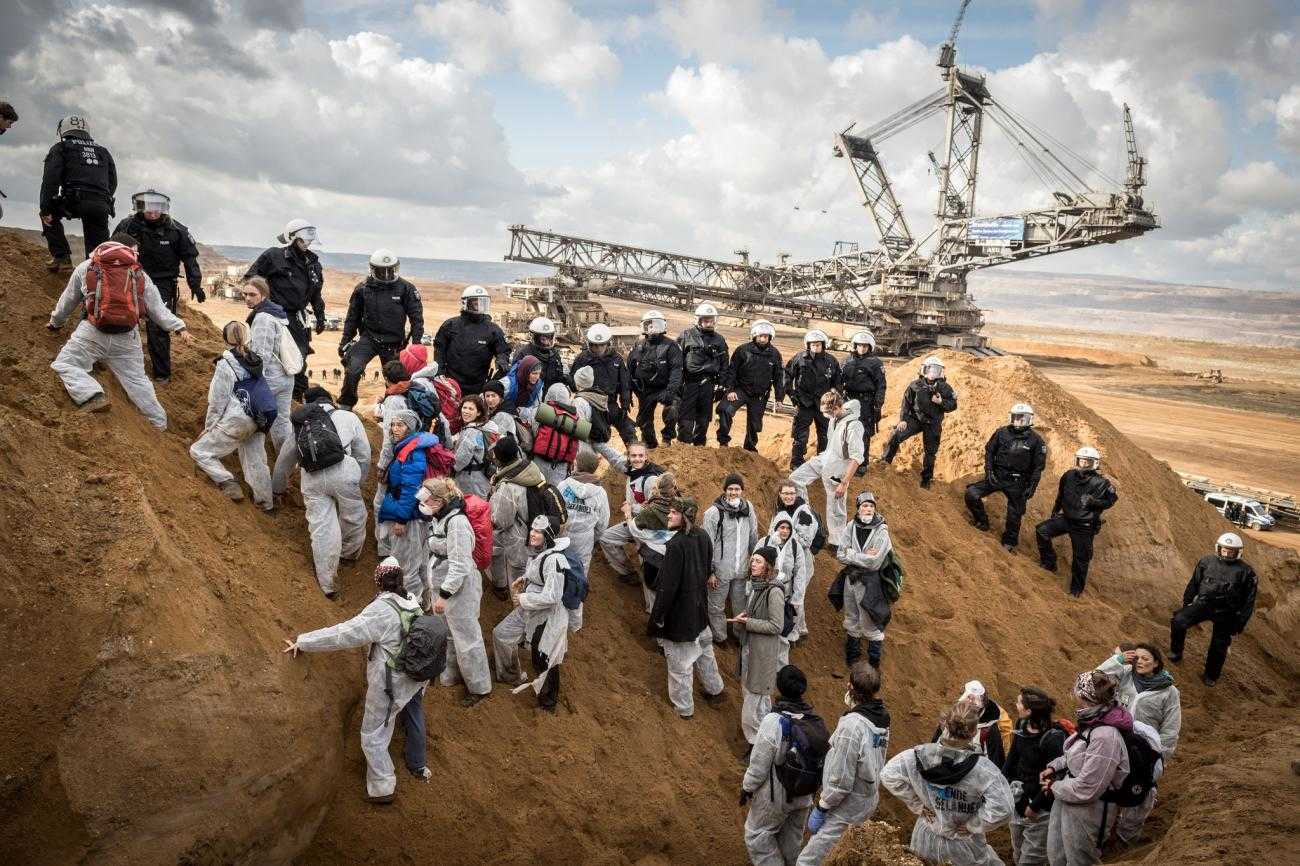
Activists move through a coal mine, escorted by police. Photo: Flickr/Ende Gelände. Licensed under CC2.0
What would your advice be to groups wanting to organise in a similar way? What challenges have you faced with organising such big actions? What have you done to overcome such challenges?
It is difficult to provide a general advice, since the conditions are so different in different contexts and countries. We do skillsharing with other movements, specifically climate groups in other countries like Czech Republic, Poland, Austria and many more, and we also learn from them. Yet you cannot mechanically transfer our way of doing things to other social, political and economic contexts.
However, there are some points that are probably helpful in many contexts:
We would recommend to have a strong message, a clear narrative that is radical and differs from those of others. In the area of climate change, people are ready for this, they do not believe signing a petition really addresses the root causes for climate change and climate injustices. When you do civil disobedience action, it also helpful if you can rely on a supportive political consensus in at least a certain part of the public. In our case, there is an official commitment of the German government to combating climate change, which is also supported by large parts of the population, yet action on the ground has been lacking – this is a contradiction we are exploiting politically.
Something like Ende Gelände also requires a strong movement, people and groups knowing each other. Trust in each other does help a great deal to put up with the strain of our quite exhausting campaigns. It is also good to have demands and forms of action that, while radical, still allow a lot of people and organisations to support them and get involved.
It is important to have good mechanisms for integrating new people in the movement and have a welcoming culture in this regard (while obviously being mindful of potential repression). There are many dimensions to this: invite people to your meetings; be welcoming once they are there and avoid talking in “insider language” at meetings; offer new people a buddy person at their first meeting who sits with them over lunch and answers questions; transparency around which jobs need to be done and encourage newcomers to also do them; ask newcomers for their views and encourage them to implement new ideas they might have; create teams of more experienced and newer people, thereby encouraging people to commit; offer skill-sharing and trainings.
Consensus-based decision-making and good moderation for meetings help. Cultivating a culture of expressing our appreciation of each other’s work and celebrating successes, while trying to learn from mistakes will probably also be helpful in many contexts.
Professional media work and strong photos will probably be helpful in many contexts as well.
What, if any, has been the role of social media and the internet in your outreach and mobilisation? What have you found to be effective?
We do use social media, because we know we can reach people this way, but we also rely on other methods and are quite aware of the pitfalls of using social media, e.g. in terms of privacy. For example, we somewhat limit the use of facebook (for political reasons), but we do use twitter and social media during the action to do press work, to spread word in the movement.
Also, activists in Ende Gelände are very aware of the negative impacts of for example excessive filming during the action as films and photos can be used by authorities and the police. We try to make sure that people who do not want to appear in photos and films do not, e.g. by designating only certain times or places in our camps for journalists to film and asking activists not to film each other without seeking prior permission.
At Ende Gelände actions, you do not find the same amount of filming as compared to e.g. the G20 summit in Hamburg, but obviously the images of the moon-like landscape swamped with determined people in white suits went around the world and we took a deliberate decision to create such images. We are also aware that is important to show our faces, and for some of us doing so is part of civil disobedience. Therefore, we always find people who are willing to speak to the press, showing their faces. Also, the drone-generated birds-eye-view of some of the digger occupations have certainly helped to spread word about our actions. Maybe you could say that pictures and the images are most powerful for Ende Gelände, not the short videos you might find on facebook or twitter.
Yet we would also acknowledge that in different countries there are different cultures concerning privacy and the use of social media. In Germany, there are possibly more concerns about surveillance, privacy etc. than in other countries, which is also reflected in our use of social media.
Ende Gelände is organised by a series of working groups, working on finances, communications, legal, action, and the camp – what are the benefits of this structure, and are there any limitations?
There are a number of advantages: People can do what they like doing and/or what they do best. The relative autonomy of these working groups means that many decisions can be taken by a small group, which is much more efficient than doing it all in the larger alliance. In the working groups, people know each other better, develop trust and often enough friendships. This is hard to do to the same extent in a larger group, but is really helpful for motivating people and crucial in planning an action that may involve breaking the law. Moreover, these groups are also units where certain issues can be preliminarily discussed, arguments be developed etc. and then once we need to discuss an issue in the larger alliance, we already have reached a certain level of clarification and understanding of the arguments, controversies, positions and possible solutions. Last not least, people obviously specialise to a certain degree in certain tasks, thereby becoming better at them over time.
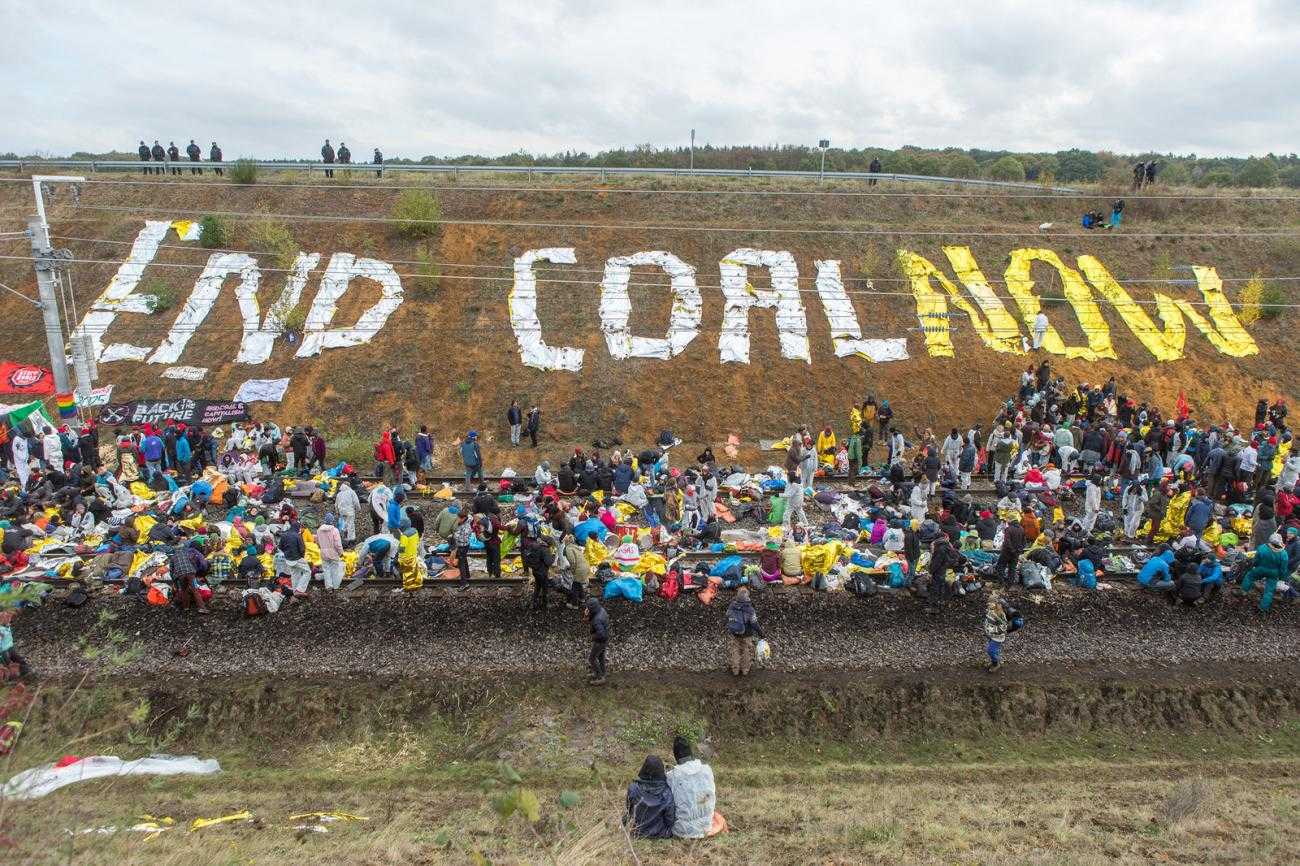
Activists blockade a train line. Photo: Flickr/Ende Gelände. Licensed under CC2.0
A disadvantage is that coordination issues may arise, especially when things get very hectic. Sometimes it is not exactly clear whether a certain task is covered by working group A or B, or it may fall through the cracks. In order to minimise such problems, we created at some stage a so called “process working group”, which is basically in charge of making sure that the overall track is on process, the work load for individuals does not become too heavy etc.
Moreover and as a more general point, since we are a German-wide network, an awful lot of our work is done via email, conference calls etc. which can be demanding. Having regular “real” meetings is quite important in our experience.
Participants in your actions are organised into affinity groups. How do you balance affinity groups having autonomy with the goals of the wider action organised by a working group? How do affinity groups influence how the action unfolds? Is the fact that people know they can expect a well-organised action with a variety of roles that they can take part in one of the reasons you've been successful in mass-mobilisation?
Our actions are not organised by one working group, but by the entire network, each working group and person contributing in their own way. And for the actual actions, we often have additional external support by people who cook, provide medical services, emotional support, training, translation, photos and many other things.
Despite all the planning and support provided by the Ende Gelände structure, affinity groups are crucial for the action. They encourage people and enhance the safety of activists. People can – ideally – prepare together both logistically and emotionally and will come together after the action again to reflect, share feelings etc.
Moreover, the Ende Gelände actions usually involve what we call a finger structure, i.e. a larger group of activists going into the action together, each to a different place and taking a different route from the other fingers. This makes it harder for the police to control us.
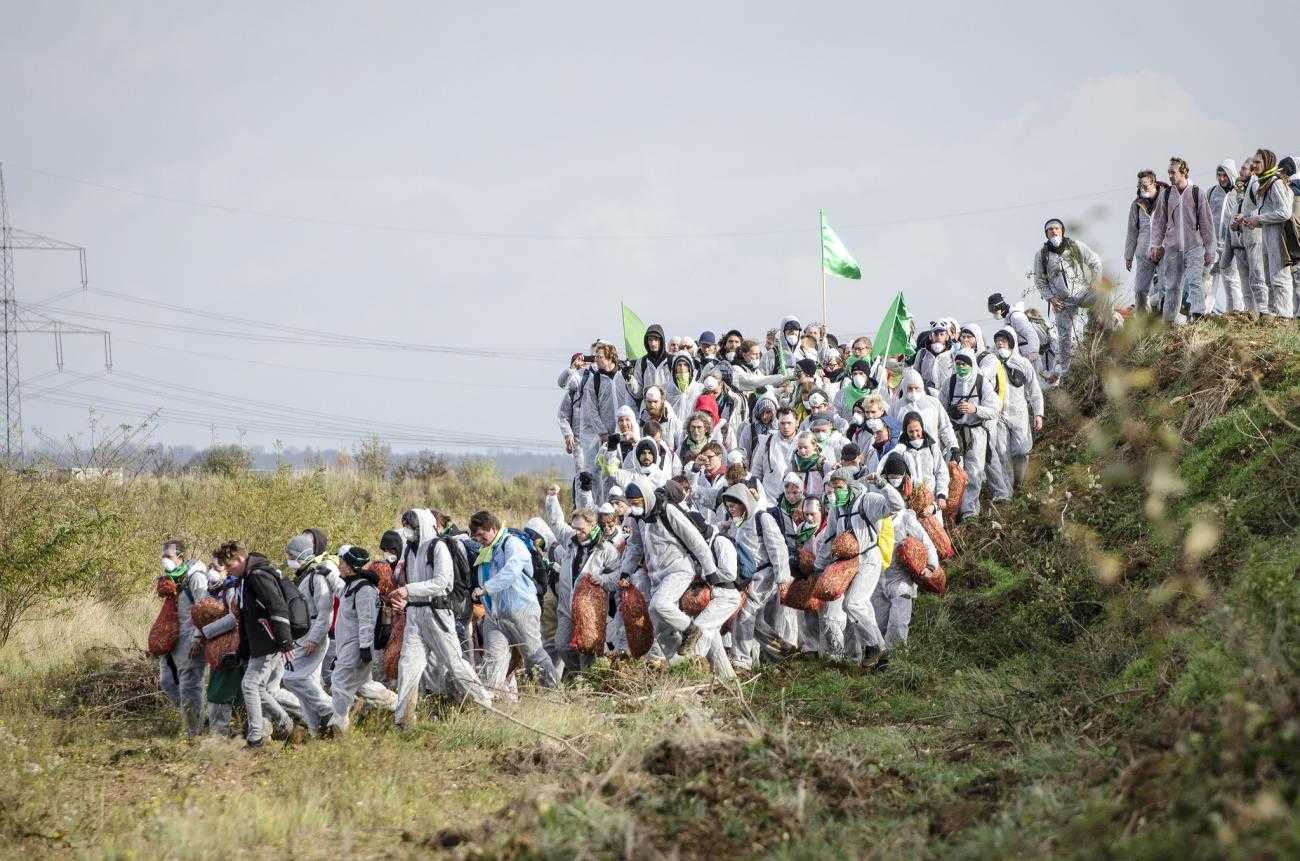
Photo: Flickr/Ende Gelände. Licensed under CC2.0
Affinity groups are crucial within these fingers: Usually, some affinity groups take over certain specific tasks within the fingers, e.g. moderation, and are prepared for doing so. Moreover, during the action, it is the activists that ultimately take the decisions on what they want to do, e.g. how long they want to maintain a blockade etc. For decision-making during the action, we often use a system of delegates from the affinity groups coming together for a speakers’ council, delegates’ meeting or similar – again, the affinity groups are crucial for this.
However, there are also climate activists that prefer actions in smaller groups over the mass actions of Ende Gelände. We try and seek to cooperate with them in a way that respects and builds on our different approaches.
Where do you see Ende Gelände going in the future? Bigger and bigger actions, or something else?
This is a topic we constantly discuss. Yet it is not the case that every action was bigger in numbers than the one before (and if it were, it is not clear whether everyone in the network would consider that desirable). We have ongoing discussions on whether we should also focus on climate-related topics other than coal (e.g. transport, agriculture). We also try to be mindful of our resources and avoid burn out among activists. But basically, we discuss every year anew what we will do.
At the same time, our network and the larger climate change movement in Germany have definitely grown over the past few years, which means that we manage to do more, in a variety of forms – it is really awesome to see a movement taking off like this.